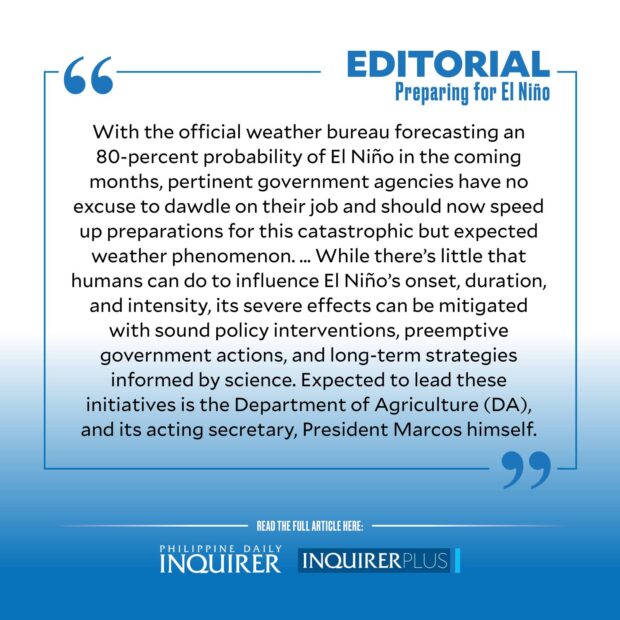Preparing for El Niño
With the official weather bureau forecasting an 80-percent probability of El Niño in the coming months, pertinent government agencies have no excuse to dawdle on their job and should now speed up preparations for this catastrophic but expected weather phenomenon. According to the Philippine Atmospheric, Geophysical, and Astronomical Services Administration, the probability of an El Niño occurrence has increased from 55 percent to 80 percent in June, July, August, and September, with an El Niño alert set to be issued next month.
El Niño, which is caused by the seasonal warming of the Pacific Ocean, upsets normal weather patterns and brings heavy rainfall in some countries, and dry spells and drought in others, including the Philippines. Fishermen from South America first noticed the phenomenon in the 1600s, and noted that it usually occurred toward the Christmas season, hence the name El Niño which refers to the child Jesus. Climate change however has broken that pattern such that El Niño may be expected in other months of the year.
This extreme weather condition has been known to cause the outbreak of diseases, heat stress, and respiratory ailments, as well as wreak devastation on agricultural lands that result in lower crop yields and, consequently, longstanding food shortages. Over the past decade, the Philippines has incurred P463 billion in damages from extreme weather events, 62 percent of that in the agriculture sector. The fisheries sector has not been spared, with warm ocean waters dispersing and driving schools of fish into deeper waters and drastically reducing one’s catch. Severe temperatures and lower ocean waters have also exposed and bleached fragile coral reefs, killed plankton, and triggered fish kills. Forest fires, degraded water sources, and other environmental risks can also be expected.
While there’s little that humans can do to influence El Niño’s onset, duration, and intensity, its severe effects can be mitigated with sound policy interventions, preemptive government actions, and long-term strategies informed by science. Expected to lead these initiatives is the Department of Agriculture (DA), and its acting secretary, President Marcos himself.
So far, the DA has outlined its plans to help the fisheries and agriculture sector cope with El Niño’s effects, including putting up more water-related infrastructure such as hydroelectric power plants, irrigation canals, and diversion dams. Small scale irrigation projects would also be developed or rehabilitated, and made available to farmers. The DA also said that it has already identified hybrid varieties of rice and other high value crops that can be planted during dry spells.
All well and good, though it remains to be seen if the agency blamed for spotty policies behind the skyrocketing prices of sugar, rice, and onions could follow through its plans and prove detractors wrong.
For his part, the President could have expounded on his announced plan for the government to slowly convert the country’s dependence on water supply from underground to surface water, since conventional wisdom has it that groundwater, being less polluted, is easier and cheaper to treat than surface water. Knowing about the risk of groundwater depletion and the reduction of water in streams and lakes, as well as the deterioration of water quality, should be enough to convince most people to go for it. The plan to help local government units install their own water supply systems should rain prove insufficient is sound, however. As is the executive order that the President said he had signed to create an office to manage the country’s water resources.
Just as noteworthy is the mitigation and adaptation plan set up by the Disaster Risk Reduction and Management Unit that includes the promotion of drought-tolerant and early maturing crop varieties, organic fertilizer to increase retention of soil moisture, the adjustment of the planting calendar, and crop shifting.
Small farmers too can actively prepare themselves for the expected drought by following a crop rotation schedule, installing drip irrigation, and shifting from water-intensive to more robust crops that can withstand hotter or drier conditions. They can also reach out to the concerned agencies, like the Bureau of Plant Industry, for technical advice on the right plant varieties, and monitor weather forecasts to be able to plan their planting season accordingly. Commercial establishments and even ordinary households should be encouraged to do their part in conserving water as well, since this precious resource would prove even more limited under the strain of El Niño.
The government too should actively honor its commitments to the Paris Agreement on climate change, and look beyond short-term solutions meant to ease the ill effects of this extreme weather event. Because the bigger picture here is that climate change is getting worse, with El Niño being an early but no less deadly manifestation. Which means no amount of preparation is ever too much.





















